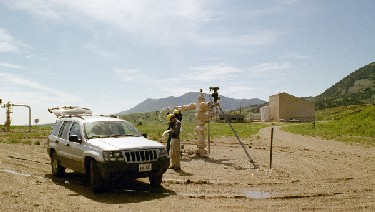
Channelling vast quantities of carbon dioxide into deep underground bunkers sounds like the ultimate have your cake and eat it solution to ambitious international CO2 emission targets. Now, a group of scientists remind us that before carbon capture and storage can become a viable option we need to first understand what happens to the CO2 once it is buried underground.
“The energy provided by coal, oil, and gas is so valuable that it is crazy to think that we will just leave it all in the ground in a carbon-constrained world” Ken Caldeira, Stanford University
The researchers, led by Stuart Gilfillan of the University of Edinburgh and the University of Manchester, studied a series of natural gas fields which are fed from beneath by natural CO2 sources. Reporting their findings in Nature, they found that over 80 % of the carbon dioxide dissolves in groundwater, with only a small fraction reacting with the cavity walls to form carbonates.
“Our findings confirm that natural gas fields can be used to store CO2 safely over millions of years. More importantly, it tells us we need to take a closer look at the mobility of CO2 dissolved in these waters,” Gilfillan told physicsworld.com.
Simple science
Despite significant investment in developing sustainable fuels, we will carry on burning coal and gas to meet at least half of global energy demand until 2030. That is according to the most optimistic forecasts of the Intergovernmental Panel on climate Change (IPCC). If so, the only way to cut carbon emissions in the short-term is to intercept the CO2 before it reaches the atmosphere.
The leading candidate for this job is carbon capture and storage (CCS), which is a relatively simple idea and could store up to 90% of carbon dioxide from power stations and industrial sites. It is a three-stage process that involves harvesting, transporting, and then storing the CO2 in suitable underground locations such as vast saline aquifers, gas and oil fields, or unmineable coal seams. To date, each stage has been demonstrated in isolation but they are yet to be combined at a significant industrial scale.
“The energy provided by coal, oil, and gas is so valuable that it is crazy to think that we will just leave it all in the ground in a carbon-constrained world. Carbon capture and storage appears to be a viable technology,” said Ken Caldeira, a global ecology researcher at Stanford University, who was recently ranked number 36 in a poll by Rolling Stone magazine of the world’s top 100 “Agents of Change”.
Going underground
In the research reported today, the scientists address an important aspect of the storage — ensuring that CO2 is safely contained. Gilfillan and his colleagues calculated what happens to CO2 over thousands of years by comparing levels of the gas with levels of the inert gas helium, based on samples from 9 natural gas fields in the US, Europe and China. In each case they found that dissolution of CO2 in the groundwater accounts for at least 82 per cent of the gas, with up to 18 per cent precipitating as carbonate minerals.
“Natural gas fields are excellent locations for potential CO2 storage as the geology is well understood and the fact that the gas field was there in the first place indicates that the cap rock seal has already held gas on a geological timescale so should be able to also hold CO2 safely,” said Gilfillan.
Latest IPCC figures predict that we could use these gas reservoirs to store up to 940 gigatonnes of CO2 — the equivalent of 37 years of total global CO2 emissions at current rates. On a global scale, saline aquifers are an even more promising option and could store 60-400 years worth of CO2, according to the same predictions.
“The physics of saline aquifers is comparable with that of gas fields, so — based on our findings — there’s no scientific reason why we can’t inject vast quantities of CO2 into them,” said Gilfillan.
These latest findings will add to a growing international push to realize workable CCS within the next few years. The European Union is on the brink of signing a 1 bn Euro agreement to fund seven CCS projects and Canada has already agreed to supply Can$2bn to finance between three and five large-scale CCS technology demonstrators that should be operational by 2015.



